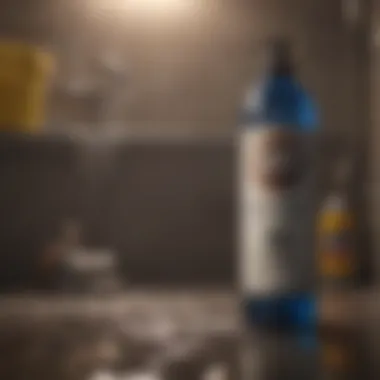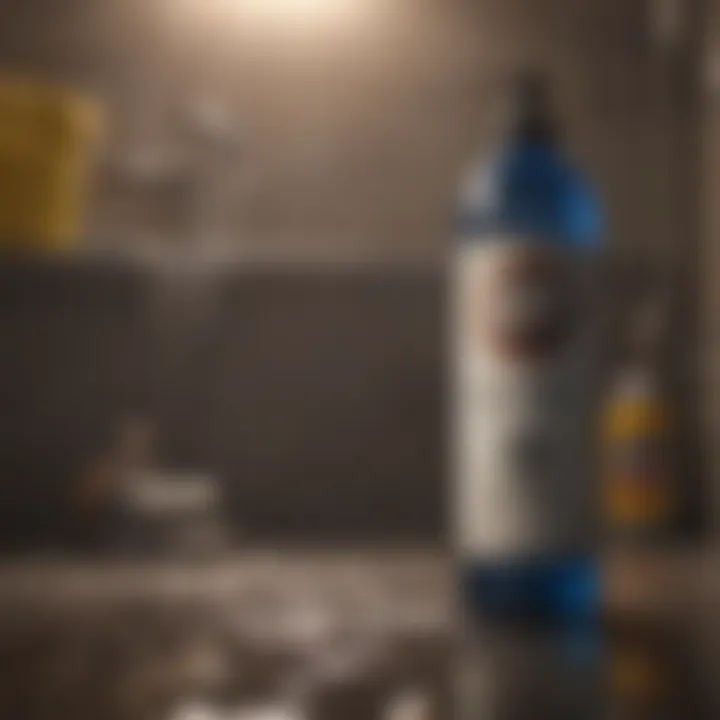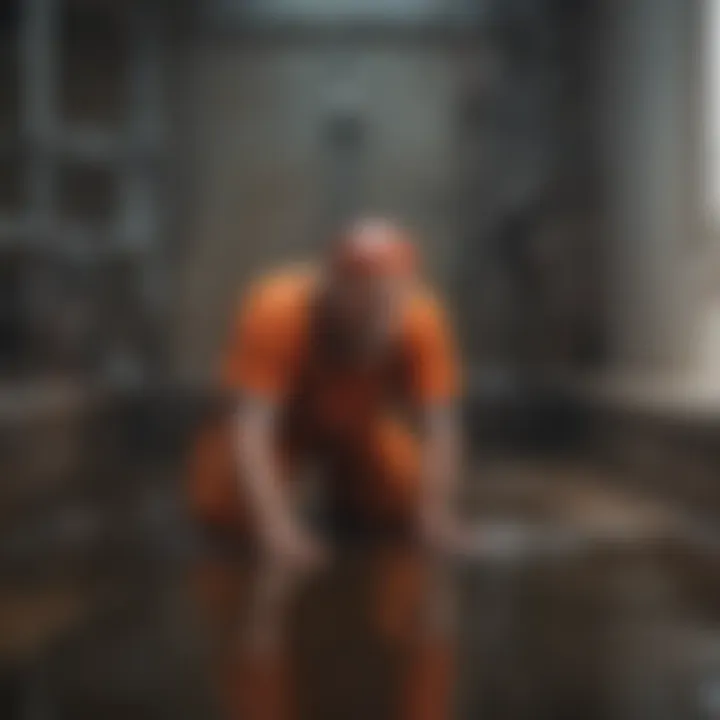Effective Methods to Unclog Hair-Clogged Drains


Intro
Hair-clogged drains are a common yet frustrating issue faced by many homeowners. Over time, strands of hair accumulate, leading to blockages that hinder the proper flow of water. Understanding effective methods for unclogging these drains is essential. Not only does it maintain comfort in your home, but it also prevents potential plumbing disasters. This guide will explore various techniques, tools, and preventive measures to deal with hair-clogged drains efficiently.
There are several approaches, ranging from simple household items to more advanced equipment. Each method's effectiveness depends on the severity of the blockage and the tools available. Homeowners often feel overwhelmed by these issues, but with the right knowledge, they can address this task head-on.
Basic Understanding of Clogs
A clogged drain usually occurs due to a mixture of hair, soap residue, and even organic matter. Understanding how these materials combine can help in choosing the right method for unclogging. Hair can tangle with other substances, creating a thick mass that water cannot easily pass through.
Regular maintenance is vital. Preventive measures such as using drain covers can reduce hair accumulation in the first place. Additionally, chemical drain cleaners, while effective, can cause damage to pipes over time, so alternative methods are often preferred.
This article aims to provide the reader with various techniques to unclog drains, along with the necessary tools and steps to follow. By implementing these methods, homeowners can ensure the longevity and functionality of their plumbing systems.
Understanding Hair Clogs
Hair clogs are a significant issue for many households. Understanding the nature of hair clogs is critical for homeowners. Recognizing the causes and impacts can empower individuals to take proactive steps. Clogs not only disrupt daily routines but also pose a risk to the plumbing system. Therefore, being informed is beneficial.
What Causes Hair Clogs?
Hair clogs mainly occur due to the accumulation of hair strands in the pipes. When hair combines with soap scum, grease, or debris, it forms a dense mass that blocks water flow. In bathrooms, the sink, tub, and shower are common areas for hair to build up. People often shed hair while grooming, which eventually goes down the drain. Over time, this accumulation can create a significant blockage.
Other factors contributing to hair clogs include:
- Using hair products that leave residues that can accumulate.
- Long hair types are more susceptible to causing clogs.
- Lack of regular maintenance, allowing debris to build up.
Impact of Hair Clogs on Home Plumbing
Hair clogs can have serious consequences for plumbing. When drains are clogged, water cannot flow freely, leading to backups. This can cause water to overflow, potentially damaging fixtures and flooring. Such frequent occurrences may result in the need for costly repairs.
Additionally, clogs can lead to:
- Increased pressure in the plumbing system, which may cause pipes to burst.
- Development of unpleasant odors due to stagnant water.
- Expensive professional services may be required to resolve severe clogs.
In summary, hair clogs can be more than just a minor inconvenience. Understanding their causes and potential impacts can motivate homeowners to maintain their plumbing better.
Recognizing Symptoms of a Clogged Drain
Detecting a clogged drain early can save homeowners significant time and expenses. Understanding the symptoms of a clogged drain is crucial in maintaining plumbing health. Identifying these signs allows for timely action, preventing further complications that can arise from neglecting drain issues. The most common symptoms include slow drainage, unpleasant odors, and unusual gurgling sounds. Each of these signs reveals important information about the state of your plumbing and indicates that intervention is necessary.
Slow Drainage
Slow drainage is often the first noticeable symptom of a hair clog. When water takes longer than usual to leave the sink, shower, or bathtub, it indicates that the drain is partially obstructed. This can happen in various locations around the home, but bathroom drains are particularly susceptible given the presence of hair.
- Common causes of slow drainage:
- Accumulation of hair strands on the drain cover.
- Buildup of soap scum mixing with hair, creating a | sticky mass.
- Other debris, such as toothpaste or small items, contributing to the clog.
Addressing slow drainage promptly can prevent a full blockage from developing. Ignoring it can lead to more severe plumbing issues.
Unpleasant Odors
Unpleasant odors emanating from drains are another clear symptom of clogging. The smell often arises when hair and organic matter decompose within the pipes. As the buildup grows, the odor tends to worsen, indicating that materials are becoming stagnant. It is essential to note that these odors can pose health risks. Prolonged exposure may lead to an uninviting home atmosphere and potential health hazards if bacteria thrive in the clogged area.
- Common smells include:
- Musty or rotten scents, suggesting organic debris is decomposing.
- A sewage-like odor, pointing to more severe issues within the plumbing system.


Addressing bad odors is crucial, not only for comfort but also for health and wellness, as this could hint at larger plumbing issues.
Unusual Gurgling Sounds
When a drain is clogged, it can produce gurgling or bubbling noises. These sounds typically occur when the water struggles to flow past the blockage. They often become more pronounced when water is draining elsewhere in the house, as air tries to escape through the affected pipes.
- Reasons for gurgling sounds include:
- Air trapped in the plumbing due to blockages.
- Water attempting to push through a narrowing drain.
- General buildup causing irregular flow.
Listening to gurgling can provide valuable hints about the state of your plumbing, allowing you to take necessary actions before a complete blockage occurs.
Identifying these symptoms early is vital in maintaining an efficient plumbing system and avoiding potential disasters.
By remaining vigilant about these signs, homeowners can ensure their drains remain functioning as they should. Recognizing these symptoms helps in exploring effective methods to resolve hair-clogged drains. It prepares individuals for the next steps necessary in keeping their plumbing problem-free.
Essential Tools for Unclogging Drains
In tackling hair-clogged drains, the right tools can make a significant difference. When you have the necessary equipment, unclogging a drain can become a more manageable task. Understanding the tools available will empower you to handle these issues effectively.
Proper tools are essential not just for removing the current blockage but also for preventing future occurrences. Each tool serves specific functions, so familiarity with them can lead to better maintenance of your plumbing system. Let’s explore each of the indispensable tools for unclogging drains.
Plunger
A plunger is one of the simplest and most effective tools for unclogging drains. Its design allows for the harnessing of air pressure. When used correctly, it can force the clog out of the drain. Most households should have a plunger readily available; it’s cost-effective and easy to use.
To use a plunger, ensure it is properly sealed around the drain opening. A good seal is important because it maximizes suction. You will then want to apply vigorous thrusts up and down to create pressure. This action can often dislodge hair and debris blocking the drain.
Drain Snake
A drain snake is a flexible, long tool designed specifically to reach deeper blockages that a plunger may not be able to remove. It consists of a coil of wire, often with a handle, allowing you to insert it into the drain and retrieve debris. There are various types of drain snakes, from manual options to electric versions, each catering to different needs.
Using a drain snake requires some technique. Insert it gently into the drain until you feel resistance. Once you locate the clog, you can either twist the snake to break apart the blockage or pull it back to remove it. It’s important to be cautious to avoid damaging pipes.
Wet/Dry Vacuum
A wet/dry vacuum is another powerful tool for dealing with drain clogs. This type of vacuum is capable of sucking both liquids and solids. It can be a useful option if other methods fail. With a wet/dry vacuum, you can connect an appropriate attachment to the drain. This enables effective suction that can pull out hair and other obstructions.
Before using, ensure that the vacuum is ready for liquid collection. After turning it on, you simply place the nozzle over the drain to create a seal and initiate suction. A wet/dry vacuum can handle more significant clogs, and its versatility makes it a valuable tool for home maintenance.
Chemical Drain Cleaners
Chemical drain cleaners are an option for more stubborn clogs. These products contain strong chemicals that can break down hair and grease build-up. They are typically found in liquid form and can be poured directly into the drain. However, caution must be exercised when using them. Follow the manufacturer’s instructions carefully and use them in a well-ventilated area.
While chemical cleaners can be effective, overuse can damage pipes, and they should never be combined with other cleaning chemicals. It's also important to wear protective gloves while handling these products.
Remember, prompt action with the right tools is key in preventing significant plumbing issues.
In summary, having these essential tools at hand can make dealing with hair-clogged drains less daunting. Each tool serves a unique purpose, and understanding when to use each one will lead to a more efficient unclogging process.
DIY Methods for Unclogging Hair Clogs
The value of DIY methods for unclogging hair clogs cannot be overstated. Not only do these approaches save time and money, but they also provide homeowners with an opportunity to engage directly with the maintenance of their plumbing system. The ease of use and availability of common household items make these methods practical for anyone facing the frustration of a slow or blocked drain.
Using Boiling Water
Using boiling water is perhaps the simplest method to address hair clogs. Hot water can dissolve soap buildup and dislodge hair strands that may be clumped together in a drain. To perform this method effectively, boil a kettle or pot of water. Then, pour it directly down the drain in a slow, steady stream. If the clog is recent and not too stubborn, this technique may resolve the issue quickly.


However, it is important to consider the type of pipes in your home. Plastic pipes might warp under extreme heat, so it is wise to ensure they are compatible before applying boiling water. Additionally, this method works best when used with other techniques for persistent clogs.
Salt and Baking Soda Solution
The combination of salt and baking soda is another effective DIY solution for hair-clogged drains. This method leverages the natural abrasive properties of salt along with the chemical characteristics of baking soda. To use this method, start by pouring half a cup of salt down the drain, followed by an equal amount of baking soda. Allow the mixture to sit for about 30 minutes.
After the waiting period, flush the drain with hot water. This solution can help break down build-up and loosen hair clogs by creating a mild abrasive action, making it easier for water to flow smoothly. Regular application of this method may also prevent future clogs, promoting ongoing drain health.
Vinegar and Baking Soda Reaction
The reaction between vinegar and baking soda is not only entertaining but also effective for unclogging hair-filled drains. This method relies on the chemical reaction that occurs when the two substances mix. To execute this technique, start by pouring half a cup of baking soda into the drain, followed by half a cup of vinegar. The chemical reaction produces fizzing and bubbling, which helps dislodge material from the pipes.
After the fizzing has subsided, wait for about 30 minutes, then flush the drain with hot water. This combination can effectively break down grease, soap, and hair clogs, making it a powerful ally in drain maintenance. As with other DIY methods, using this approach regularly can minimize the chances of severe clogs developing in the future.
Using a Plunger Effectively
Using a plunger is a fundamental skill every homeowner should master when facing hair-clogged drains. It is often the first line of defense against minor clogs. This tool is both cost-effective and simple, making it accessible for most people. Understanding how to use a plunger effectively can save time and prevent further complications in your plumbing system.
A plunger works by creating pressure and suction that dislodges blockages. This technique is particularly useful in cases where hair accumulates near the drain's entrance. Regular use can prevent more serious issues from developing. For instance, if you notice slow drainage, acting promptly with a plunger may avoid having to resort to harsher methods or costly plumbing services.
Choosing the Right Plunger
Not all plungers are created equal. There are two main types available: cup plungers and flange plungers.
- Cup Plungers: These have a simple rubber cup at the bottom. They are most effective for flat surfaces like sinks. While they can work for minor clogs, they may struggle with deeper blockages.
- Flange Plungers: These plungers feature a bell-shaped rubber flap. They are designed for toilets but can be effective in sinks and tubs as well. Their wider surface allows improved suction, which can be particularly beneficial for hair-clogged drains.
It is advisable to select a plunger that best fits your needs based on the type of drain being cleared. A flange plunger is likely to yield better results in most scenarios due to its design.
Proper Technique for Unclogging
Using a plunger effectively requires more than just the right tool. Here are key steps to follow:
- Preparation: Ensure the area around the drain is clean. Remove any debris from the surface. If the clog is in the sink, fill it with enough water to cover the cup of the plunger.
- Positioning: Place the plunger directly over the drain, ensuring a tight seal around it. Avoid partial coverage as this can lead to ineffective suction.
- Technique: Push down gently at first and then pull up sharply. Repeat this motion. The goal is to create a rhythm of pressure and suction. About 15 to 20 vigorous pumps usually suffice to dislodge common hair clogs.
- Test: After several attempts, check if the water drains properly. If not, repeat the technique or consider another method.
Using a plunger is a simple yet effective way to maintain your drain health and manage hair clogs before they escalate into bigger issues.
Mastering the art of plunging ensures that a homeowner is well-equipped to handle the most common drain issues, thereby protecting their plumbing systems from the pitfalls caused by neglect.
Employing a Drain Snake
A drain snake is a key tool when it comes to effective methods for unclogging drains blocked by hair. It allows homeowners to reach deeper into the plumbing, far beyond what other basic methods, like plungers, can achieve. Using a drain snake is especially important when you are dealing with stubborn clogs that have built up over time, as hair can create compact barriers that are difficult to dislodge using mere topical solutions.
Types of Drain Snakes
There are several types of drain snakes available, each suited for specific situations. Here are a few common types:
- Handheld Drain Snakes: These are typically shorter and meant for smaller, bathroom drains. They can effectively remove hair and other debris manually.
- Electric Drain Snakes: These are more powerful and used for larger clogs, often found in kitchen or main drains. They are ideal for tougher blockages where additional force is required.
- Toilet Augers: Specifically designed for toilet drains, they have a flexible wire and a crank handle for maneuvering tight bends to clear clogs without damaging the porcelain.
Proper Usage of a Drain Snake
Using a drain snake correctly is crucial for effective unclogging. Improper use can lead to damage in your plumbing or can fail to clear the clog. Here’s how to effectively use a drain snake:
- Insert the Snake: Slowly push the snake into the drain until you feel the resistance of the clog. Make sure to do this gently to avoid damaging the pipes.
- Rotate the Handle: Begin turning the handle of the snake. This rotating motion helps the snake catch onto the blockage.
- Pull Back: After a few rotations, pull the snake back out while still turning the handle. This action can help retrieve hair or debris attached to the snake.
- Repeat if Necessary: If the clog remains, repeat the process until water flows freely.
- Flush Thoroughly: After removing the clog, run hot water down the drain to clear any residual debris.
Using a drain snake is a preferred method as it can reach deeper into pipes and effectively remove blockages that are beyond what an ordinary plunger can handle.
Chemical Options for Deep Clogs


Chemical drain cleaners are often considered a last resort for homeowners dealing with persistent hair clogs. These products can be effective in breaking down blockage, especially when other methods like plunging or using a drain snake have failed. Understanding their proper application and risks is essential for successful use.
Using chemical cleaners has distinct benefits. They are typically easy to apply, requiring minimal tools and effort. Most available products work quickly, providing results within minutes. They can also penetrate deep into drains, targeting not just hair but also grease and soap residue. However, misusing these products can lead to greater problems.
Types of Chemical Cleaners
There are several types of chemical cleaners available on the market. Here’s a breakdown:
- Caustic Cleaners: These contain sodium hydroxide, which reacts with water to produce heat. This heat can dissolve hair and other organic materials. Brands like Drano and Liquid-Plumr fall into this category.
- Acidic Cleaners: These often contain sulfuric acid or hydrochloric acid. They are powerful and can dissolve hair and other stubborn blockages. However, their strong corrosive nature can be damaging to pipes, especially older ones.
- Enzyme Cleaners: These are less abrasive and work slowly. They contain enzymes that break down organic material over time. While safer for pipes, they may require repeated applications.
Using the right type of chemical cleaner can lead to effective unclogging without damaging your plumbing system.
Always read the instructions on any product to ensure proper usage and safety.
Safety Considerations
Safety should be a priority when using chemical drain cleaners. Many of these products contain strong acids or bases, which can cause serious injuries. Here are important considerations:
- Wear Protective Gear: Always use gloves and goggles to protect your skin and eyes.
- Ventilation: Ensure the area is well-ventilated when applying chemical cleaners. The fumes can be harmful if inhaled.
- Do Not Mix Products: Mixing different types of cleaners can lead to dangerous reactions. Follow instructions on the label to avoid combining products.
- Follow Disposal Guidelines: Dispose of chemicals according to local regulations. Many cleaners should not be poured down the toilet or other drains.
By understanding the chemical options available and adhering to safety measures, homeowners can manage hair clogs more effectively.
Maintaining a Clog-Free Drain
Maintaining a clog-free drain is not just about convenience; it can prevent costly plumbing issues and ensure your home remains hygienic. Hair, soap, and other debris can accumulate in your drains over time. This buildup can lead to serious clogs, which may necessitate professional intervention or extensive cleaning efforts. Incorporating regular maintenance routines and preventive measures can significantly reduce the likelihood of these clogs.
Homeowners should take the task of drain maintenance seriously. A simple weekly check can prevent minor problems from escalating. Regular maintenance helps in recognizing early signs of clogging and addresses them before they become severe. Moreover, this keeps the plumbing system functioning efficiently, ultimately enhancing your home's comfort.
"An ounce of prevention is worth a pound of cure."
Keeping your drains clean saves effort and resources in the long run.
Regular Cleaning Tips
Implementing regular cleaning routines is essential in keeping your drains clear of obstruction. Here are a few practical tips to maintain unclogged drains:
- Hot Water Flush: Pour boiling water down your drains once a week. This helps dislodge any grease or soap scum that might be beginning to build up.
- Use a Drain Strainer: Prevent hair and larger debris from entering your drains by using a strainer. Clean it regularly to ensure it remains effective.
- Weekly Baking Soda and Vinegar: Pour half a cup of baking soda followed by a half cup of vinegar into the drain. Allow it to fizz for about 30 minutes before rinsing with hot water. This natural method helps to break down any buildup.
Establishing these routines creates small, manageable tasks that vastly improve the long-term functionality of your drain systems.
Preventive Measures
Taking proactive preventive measures can help you avoid major plumbing problems. Here are some strategies:
- Educate Family Members: Teach everyone in the household about proper disposal habits. Hair should be removed from brushes and not washed down the sink or shower.
- Use a Drain Cover: Regularly use drain covers in bathrooms and kitchens to catch hair and food particles. It's a simple yet effective method to minimize what enters the plumbing.
- Frequent Inspection: Check visible pipes occasionally for leaks or corrosion. Addressing these problems early can prevent bigger issues later.
By implementing both regular cleaning tips and preventive measures, homeowners can enjoy clear and easily functioning drains, thus avoiding unpleasant and inconvenient clogs.
When to Call a Professional
In the intricate matter of unclogging hair-clogged drains, knowing when to relinquish control and seek professional expertise is crucial. While DIY methods often prove effective for minor blockages, certain signs indicate that the issue may be beyond personal remedies. Professional plumbers possess the right training and tools to address more intricate plumbing problems, ensuring a more thorough resolution. Reaching out to a professional not only saves time but often safeguards against further damage to your plumbing system.
Signs of Severe Clogging
Recognizing the signs of severe clogging can guide your decision to call a professional. Look for the following indicators:
- Multiple Drains Involved: When several fixtures are draining slowly or producing backups, it signals a central plumbing issue rather than isolated blockages. This situation may highlight more significant underlying problems, such as sewer line issues.
- Persistent Odors: Foul smells emanating from drains can be a sign of serious clogs, often indicative of decomposing material or stagnant water. This requires immediate attention to prevent health hazards.
- Backflow: If water from one fixture is backing up into another, it could mean that the sewer line is obstructed. This situation requires professional intervention as it can lead to extensive damage.
- No Improvement After DIY Attempts: If you've tried various methods without success, it is time to bring in an expert. Continuing to attempt DIY solutions can exacerbate the problem and lead to costly repairs.
Choosing the Right Plumber
When the decision to contact a professional is made, selecting the right plumber becomes pivotal. Several factors should be considered before making this choice:
- Experience and Qualifications: Check the plumber’s experience, as well as licenses and certifications. A well-trained professional is more likely to efficiently resolve plumbing issues.
- References and Reviews: Look for customer testimonials or ask for references. Experienced plumbers will usually have a record of satisfied customers, indicating their reliability and service quality.
- Licensing and Insurance: Ensure the plumber is licensed and insured. This protects homeowners from potential liability in case of accidents during the work.
- Estimate Upfront: Before agreeing to any work, request an estimate. A reputable plumber should provide a clear outline of expected costs, preventing unpleasant surprises later.
- Response Time: Choose a plumber who can respond quickly, especially during emergencies. Plumbing issues can escalate into significant problems if not attended to promptly.
Knowing these signs and having a plan for choosing the right plumber can streamline dealing with serious drain issues. It provides peace of mind, knowing that a qualified expert will handle the situation.















